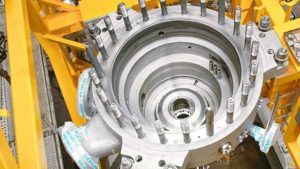What is compressor surge?
One of the key problems in the discussion of surge control is the definition of what is being controlled. This is due to two reasons: First, surge is a system phenomenon, that only exists due to the interaction of a system of pipes, valves and volumes (in short “the piping system”), and a compressor.
This is an excerpt from a tutorial, "What is surge", by Jeffrey Moore of Southwest Research Institute, Klaus Brun then of Southwest Research, and Rainer Kurz of Solar Turbines.

The second reason is that the concepts of stall, rotating stall, mild surge, and violent surge are often used inaccurately, or interchangeably. So, let us start with a few definitions: For the purpose of this discussion, surge is considered a situation where the flow through the entire compressor is reversed intermittently, in other words gas is flowing from the discharge nozzle to the suction nozzle.
This is what is often referred to as violent surge, and the intermittent nature of the flow reversal creates large forces capable of damaging compressor bearings, seals, and other rotating elements. There is also something called mild surge. This is also an instability, but without the full reversal of flow. The essential fact is that the same compressor can develop mild surge or violent surge, depending on the geometry (especially the volume) of the piping system upstream and downstream of the compressor. Similarly, the surge frequency depends on the piping system.
Stability in the sense of the definition above means, that a finite flow fluctuation in the system will not be amplified by the compressor. In general, a compressor map with a negative slope of the head-flow curve reacts to a small reduction in flow with an increase in head, thus counteracting the disturbance.
A compressor with a positive slope would reduce head, and thus amplify the disturbance. It is, therefore, convenient (but not entirely correct, Botros, 2008) to define the point of the head flow curve with a horizontal tangent as the stability limit .
Stall, on the other hand is an aerodynamic phenomenon in the compressor. If the flow through a compressor at constant speed is reduced, the losses in all aerodynamic components will increase. Eventually the flow in one of the aerodynamic components, usually in the diffuser, but sometimes in the impeller inlet, will separate. It should be noted that stall usually appears in one stage of a compressor first.
Stall may be a precursor to surge, but it does not necessarily have to be. Especially multistage compressors may still show increased head at a reduction of flow despite the fact that stall occurs in one of the stages. Stall is often detected by increased vibrations of the compressor rotor.
Flow separation in a vaneless diffuser means, that all or parts of the flow will not exit the diffuser on its discharge end, but will form areas where the flow stagnates or reverses its direction back to the inlet of the diffuser (i.e., the impeller exit).
Stall in either the impeller inlet or a vaned diffuser is due to the fact that the direction of the incoming flow (relative to the rotating impeller) changes with the flow rate through the compressor. Usually, vanes in the diffuser reduce the operating range of a stage compared to a vaneless diffuser. Therefore, a reduction in flow will lead to an increased mismatch between the direction of the incoming flow the impeller was designed for and the actual direction of the incoming flow. At one point, this mismatch becomes so significant that the flow through the impeller breaks down.
Flow separation can take on the characteristics of a rotating stall. When the flow through the compressor stage is reduced, parts of the diffuser experience flow separations. Rotating stall occurs if the regions of flow separation are not stationary, but move in the direction of the rotating impeller (typically at 15-30% of the impeller speed). Rotating stall can often be detected from increasing vibration signatures in the sub-synchronous region. Onset of stall does not necessarily constitute an operating limit of the compressor.
In fact, in many cases, the flow can be reduced further before the actual stability limit is reached. At flows lower than the flow at the stability limit, practical operation of the compressor is not possible, and the compressor cannot produce the same head as at the stability limit. Therefore, the compressor is no longer able to overcome the pressure differential between suction and discharge side.
Because the gas volumes at the compressor discharge are now at a higher pressure than the compressor can achieve, the gas will follow its natural tendency to flow from the higher to the lower pressure: The flow through the compressor is reversed. Due to the flow reversal, the system pressure at the discharge side will be reduced over time, and eventually the compressor will be able to overcome the pressure on the discharge side again.
If no corrective action is taken, the compressor will again operate to the left of the stability limit and the above-described cycle is repeated: The compressor is in surge. The observer will detect strong oscillations of pressure and flow in the compression system. It must be emphasized that the violence and the onset of surge are a function of the interaction between the compressor and the piping system. For understanding this interaction, it is useful to consider that the suction and discharge pressure the compressor “sees” at any instant is imposed by the piping system, and the compressor, for a given speed (or available power), will react to this with a certain amount of flow. For fast changes in conditions, if the discharge pressure imposed on the compressor exceeds the capability of the compressor, it will slide towards surge.